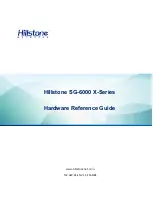
NetDefendOS for hostnames to be translated to IP addresses.
Serial Console CLI Access
The serial console port is a local RS-232 port on the NetDefend Firewall that allows direct access to
the NetDefendOS CLI through a serial connection to a PC or dumb terminal. To locate the serial
console port on D-Link hardware, see the D-Link Quick Start Guide .
To use the console port, the following equipment is required:
•
A terminal or a computer with a serial port and the ability to emulate a terminal (such as using
the Hyper Terminal software included in some Microsoft Windows™ editions). The serial
console port uses the following default settings: 9600 bps, No parity, 8 data bits and 1 stop bit.
•
A RS-232 cable with appropriate connectors. An appliance package includes a RS-232
null-modem cable.
To now connect a terminal to the console port, follow these steps:
1.
Set the terminal protocol as described previously.
2.
Connect one of the connectors of the RS-232 cable directly to the console port on the
NetDefend Firewall system.
3.
Connect the other end of the cable to the terminal or the serial connector of the computer
running the communications software.
4.
Press the enter key on the terminal. The NetDefendOS login prompt should appear on the
terminal screen.
SSH (Secure Shell) CLI Access
The SSH (Secure Shell) protocol can be used to access the CLI over the network from a remote
host. SSH is a protocol primarily used for secure communication over insecure networks, providing
strong authentication and data integrity. SSH clients are freely available for almost all hardware
platforms.
NetDefendOS supports version 1, 1.5 and 2 of the SSH protocol. SSH access is regulated by the
remote management policy in NetDefendOS, and is disabled by default.
Example 2.2. Enabling SSH Remote Access
This example shows how to enable remote SSH access from the lannet network through the lan interface by
adding a rule to the remote management policy.
Command-Line Interface
gw-world:/> add RemoteManagement RemoteMgmtSSH ssh Network=lannet
Interface=lan LocalUserDatabase=AdminUsers
Web Interface
1.
Go to System > Remote Management > Add > Secure Shell Management
2.
Enter a Name for the SSH remote management policy, for example ssh_policy
3.
Select the following from the dropdown lists:
•
User Database: AdminUsers
2.1.4. The CLI
Chapter 2. Management and Maintenance
39
Содержание DFL-1600 - Security Appliance
Страница 27: ...1 3 NetDefendOS State Engine Packet Flow Chapter 1 NetDefendOS Overview 27 ...
Страница 79: ...2 7 3 Restore to Factory Defaults Chapter 2 Management and Maintenance 79 ...
Страница 146: ...3 9 DNS Chapter 3 Fundamentals 146 ...
Страница 227: ...4 7 5 Advanced Settings for Transparent Mode Chapter 4 Routing 227 ...
Страница 241: ...5 4 IP Pools Chapter 5 DHCP Services 241 ...
Страница 339: ...6 7 Blacklisting Hosts and Networks Chapter 6 Security Mechanisms 339 ...
Страница 360: ...7 4 7 SAT and FwdFast Rules Chapter 7 Address Translation 360 ...
Страница 382: ...8 3 Customizing HTML Pages Chapter 8 User Authentication 382 ...
Страница 386: ... The TLS ALG 9 1 5 The TLS Alternative for VPN Chapter 9 VPN 386 ...
Страница 439: ...Figure 9 3 PPTP Client Usage 9 5 4 PPTP L2TP Clients Chapter 9 VPN 439 ...
Страница 450: ...9 7 6 Specific Symptoms Chapter 9 VPN 450 ...
Страница 488: ...10 4 6 Setting Up SLB_SAT Rules Chapter 10 Traffic Management 488 ...
Страница 503: ...11 6 HA Advanced Settings Chapter 11 High Availability 503 ...
Страница 510: ...12 3 5 Limitations Chapter 12 ZoneDefense 510 ...
Страница 533: ...13 9 Miscellaneous Settings Chapter 13 Advanced Settings 533 ...















































